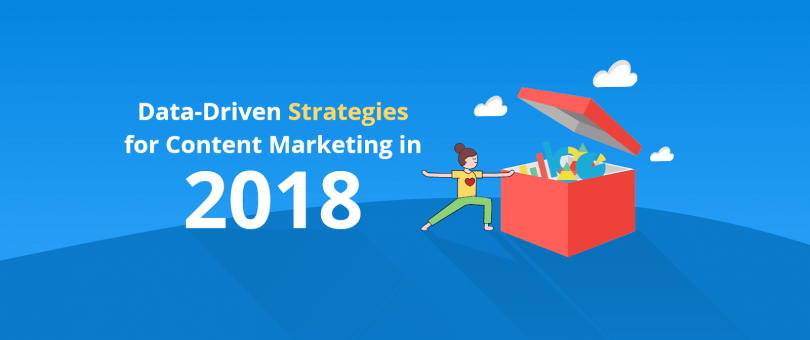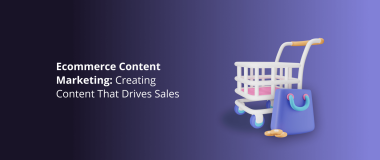With the rising number of content creators and publishers, the competition in content marketing for the consumer’s attention is ferocious. The purchasers’ attention span is in decline and as a result, it is crucial to understand content marketing trends and where the industry is going.
To help you stay on track, we’ve collected the following 13 content marketing stats and the strategies that can help you reinforce your content marketing strategy.
DevriX Recommends: Your Complete Data Analytics Guide To Help You Improve Your Business
1. 35% of B2B Marketers Measure ROI (Content Marketing Institute)

Measuring ROI can be one of the biggest challenges for marketers. Which is why only 35% of B2B marketers analyzed the results of their content efforts, according to CMI.
But, it’s not a challenge if it doesn’t bring a positive outcome after completion. The right measurements can take you straight to the wanted results. When it comes to measuring content marketing ROI, the exposure and the engagement rate.
Just writing a blog post on your website and publishing it on social media is often not enough. You need to always pay attention to metrics such as social shares, clicks, and interactions with the posts. These metrics are directly related to the conversion rate of your content marketing strategy.
To assess your content marketing ROI appropriately, you’ll need the right tools to do it:
- Google Analytics – One of the most important tools for content performance analysis. The data that you’ll gather with GA will become your foundation for assessing and modifying your content marketing strategy and its performance.
- SEMRush – This tool will help you gain insights on how to improve your content in the eyes of both users and search engines. You can gauge your content’s performance based on backlinks, social reaction, and user behavior signals.
- BuzzSumo – By entering your search preferences and criteria into the tool’s input, BuzzSumo analyzes the online content for you and finds the pieces that will work the best for your content marketing strategy.
DevriX Recommends: Hot to Use BuzzSumo for Your Content Marketing Strategy
2. 55 Percent of Bloggers Update Older Articles (Orbit Media)

Today, publishing a blog post and just leave it there is not enough to keep good SEO score and results with your target audience. You need to make sure that your older content is still applicable.
If you don’t want your articles to become trivial as the industry trends develop further, you need to recycle them and update on a regular basis. By doing this, your audience will keep coming back to read your posts and stay up-to-date with the industry.
On top of that, Google also loves fresh content. With that in mind, you need to analyze your blog and find older topics that are still relevant to your target audience.
3. 73 Percent of B2B Marketers Use Case Studies For Content Marketing Purposes (CMI)

Writing and publishing articles is essential when it comes to content marketing. It builds brand awareness, domain authority, and promotes your business. But, what about case studies?
With the help of case studies, you can showcase the entire buying journey of your target client. This is significantly beneficial because you’ll remove every possible doubt of your future customers about how you work with clients.
For prospects, it’s a lot easier to trust a business when the process is demonstrated in details.
Recommended: DevriX WordPress Portfolio and Case Studies
4. The Average Blog Post Length is 1,142 Words (Orbit Media)

With every shift in search engine algorithms, the competitiveness to be ranked better on Google is remarkably increased. Long-gone are the days when shorter blog posts of 500-600 words were enough.
Today, Google thoroughly inspects every piece of content for quality and relevancy and as a result, the average length of a well-ranked article has increased over the years.
Users too got way savvier than they used to be. Long-tail keyword searches are performed every day for every industry, including yours, so it’s really important for your content strategy to match those queries.
You need to create long-form content for better search engine optimization and increased conversion rate. It’ll perform better with your audience and the prospects will get more value compared to something that scratches the surface.
5. 43 Percent Of People Only Skim Blog Posts (Hubspot)

Writing the article is actually a lot easier than making people read the article. Blog posts are there to be read, and your prospects need to gain benefits from reading the posts. Unfortunately, more and more readers just skim the articles to find the benefits that they were looking for when they clicked on the blog link. To increase the readability of your blog posts, do the following:
- Captivating and Benefit-focused Headline – When people read newspapers, the first thing they see is the cover and the headlines. It’s the exact same principle when people look at your blog page. Headlines or titles are the principal and the most influential element of your blog page. Don’t take them nonchalantly or reckon that no one cares.
- Powerful Words – Strong words result in stronger content. Proverbs, idioms, exclamations are all part of powerful phrases in content. They’re also integral if you want to create a persuasive content. These words inspire your readers and make them read on and take action after reading the post.
- Use Attractive Visuals – Another good tactic to increase your blog readability. Visuals are excellent if you want to add up to your main story in the post. CMO Council says that 65% of senior marketing executives make photography vital to their marketing and storytelling strategies.
Related: How To Deliver Your Message Quickly Through Visualization
6. Content Marketing Brings 3 Times More Leads Than Traditional Marketing (CMI)

Not only that is more economical than outbound marketing, but it is also more effective. Sponsoring and outbound is the old way of marketing. Outbound is too promotional and pushy for modern consumers. On the other hand, content marketing provides value for your specific target audience, organically builds your subscriber base, and fosters long-term relationships.
Instead of placing ads on the consumer’s screen, you need to publish valuable material that your target audience finds relevant. With that, you give something that is really useful for the audience and if the prospects love it, they’ll come back for more.
7. 63 Percent Of Marketers Create Content With Target Persona in Mind (Hubspot)

When you develop your content, it is of vital importance to write with a target persona in mind. You need to have a specific goal for each piece of content that you create. If you haven’t yet figured out your target persona, you need to analyze and define it ASAP.
Recommended: The Complete Guide To Finding Your Target Market
When you know your target buyers, you’ll know their problems and pain points and you need to know how to address them. Details you should learn about your target customers are:
- Problems and Pain Points
- Purchasing Power
- Content Consuming Habits
- Job and Career
- Income
8. Voice Search Is on The Rise (Search Engine Land)

According to Search Engine Land, up to 20% of Google searches are done with voice. This means that you need to think about the types of keywords and titles that people search with their voice.
Voice is on the rise and will continue to have an effect on content marketing. The usage of AI assistants such as Alexa and Apple’s Siri is increased too and most of the smartphones today come with voice assistants. You need to think about how your target customers use these devices and what do they search with their voices when they use them.
9. Social Media Is The Most Common Content Marketing Delivery Tool (Neil Patel)

Social media networks like Facebook, LinkedIn, Twitter and Instagram have changed the entire content publishing industry. They also altered the way that people communicate.
It’s free to join on any social media network and create a company page. Your only expenses on social media will be paid promotions and your time. But, don’t rely too much on paid advertising when you promote your content on social media.
If you want to truly reap the benefits of social media marketing, you need to be focused on the social aspect of the networks. Provide value with your content and build a connection with your fans and followers. Then, bring them to your landing pages and nurture the people that are most interested in your content and products.
Related: [Infographic] 10 Actionable Tips to Make Social Media Work for Your Brand
10. 49 Percent Of Marketers Align Content With Different Buying Stages (Neil Patel)

Your customers need to go through several stages before they purchase your product. Sometimes your prospects move fast through the stages and sometimes they move slower. You need to develop content that will be lined up with the buying stages.
Buying journeys can be different depending on the product or service but, the elemental stages remain the same:
- Awareness – Prospects realize that they have a problem and need a solution. They research and find your content useful in addressing their pain points.
- Consideration – The prospects’ needs are now clear and they’re considering their options. They know that you can offer them a solution but, they’re still not ready to purchase and still evaluate other choices. This is a good time to offer them a case study, expert guide or explanation video.
- Decision – At this stage, the prospects need to make a decision. They’ve done their research, handpicked the best options and they’re ready to buy. At this stage, you need to put the value that you offer in the spotlight with a complete product guide, comparisons, customer reviews, and testimonials.
- Purchasing – At last, your target personas become your customers. This doesn’t mean that you should end with your content marketing strategy. Your buyers will still be interested in user guides, product articles, exclusive customer newsletters, surveys, loyalty programs etc.
11. 61 Percent Of Marketers Want To Increase Organic Presence (Hubspot)

Organic content marketing is all about bringing people to your content without paid promotions and advertising. It is a long-term method that brings long-term results for your business.
Today’s consumers learned how to ignore ads. To set up an ad is easier than building your SEO score from the ground up. This requires an attentive approach when you develop your content and promoting it on social media.
To increase your content’s organic presence, make sure that you do the following:
- Write For Target Personas – Know the type of people that really need to read your content. By creating content that answers their questions, you’ll naturally improve your SEO score. Tap into your customer’s problems and use the main keywords to optimize your content.
- Use Long-Tail Keywords – For your content, use keywords that are more specific for the searches that your target customers make online. If you optimize good enough for your niche long-tail keywords, Google will recognize your website as an excellent destination for a particular topic that people search, and it will push you higher in the organic search results.
- Link Internally – When you build your blog, you can find places in your articles where you can include your own link that is related to the topic of the article, of the particular paragraph. Just don’t overdo it if you don’t want to look spammy.
- Build Social Media Presence – You need to be present with your articles on social media sites like Twitter, LinkedIn, Google Plus and Facebook. Sharing your content there will help for your brand recognition on the internet. Also, other people and fans can share your content too, which is excellent for your organic online presence.
DevriX Recommends:
Smart Ways To Effectively Conduct SEO Campaigns: Preparation (Part 1)
Smart Ways To Effectively Conduct SEO Campaigns: 12 Tactics (Part 2)
12. Infographics are 30x more likely to be read than text articles (Daily Infographic)

Source: www.flickr.com
As humans, we are wired to pay attention to visuals. Infographics are visuals that can interpret complicated data into something that your audience can understand, in a plain and interactive way. This type of visual content can be effective for your content marketing strategy because:
- Grabs Attention – Infographics are enjoyable and easy to digest content. This increases your chances of being perceived and read by audiences.
- Drives Traffic – Beautiful infographics get the most shares on social media. This amplifies your social media reach and sends more users to your website.
- Make People Stay Longer – Infographics can keep people longer on your website. They encourage users to look around, stay with the content and the longer they stay, the better are the chances to become your clients.
Related: [Infographic] How to Make a Strong Digital Marketing Strategy
13. Four Out Of Five Businesses Distribute Articles Via Email Marketing (CMI)

Articles are really important. But, distribution is also vital for online success. This is where email marketing steps in. With email marketing, you can get up to $38 for a $1 spent.
Content marketing is nothing without an email marketing strategy. Emailing to your subscribers provides you with the opportunity to promote your latest content and your best products. It can be your mechanism for bringing relevant traffic to your site.
If your subscribers love your content, they’ll pass it on to their friends and followers too. To make the most of your email marketing for your content strategy, remember the following:
- Constantly Build Your List – The bigger the email list, the bigger affect your content will have. However, don’t you dare to buy an email list! If the users didn’t voluntary subscribe to your list, your messages will go straight to the ‘SPAM’ box and put your entire content strategy and business at risk.
- Highlight Value – Your email messages should provide nothing but value for your subscribers. Send them your best content, offer them discounts and regularly inform them about what’s new with your brand and industry.
Related: [Infographic] 24 Fundamental Email Marketing Stats
Wrapping Up
We live in the informational era, it’s a fact. Your target customers know that they have 24/7/365 access to the largest pool of data that can help them make better decisions when it comes to choosing a product or service.
This is why you must align your content marketing strategy with their problems and needs. You must create informative and applicable content that will be their main go-to resource. For that, you need to always understand your customers and customize your content on the go.



![6 Ways to Strengthen Your B2B Content Marketing Strategy [Part 1]](https://devrix.com/wp-content/uploads/2019/12/6-Ways-to-Strengthen-Your-B2B-Content-Marketing-Strategy-Part-1@2x-380x160.png)
